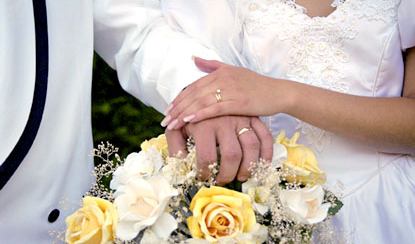|
More
then their cooling properties, bindis worn by women is also the reminder
of their wedding vows, because a bindi is worn by Hindu married women to
symbolize their marriage. Myth is that it protects them from the bad eye
of people. However, today the religious significance of the bindi is
largely forgotten and it is worn as a fashion accessory.
This
traditional Hindu adornment is known by many names: Bindhi, Pottu,
Tilakam, and Tika. It is worn on the forehead.

Indian
woman wearing a Bindi
It comes in many shapes - a round dot, a graceful frozen flame and other
exotic adventurous forms. Traditionally the bindhi or kumkum is
auspicious with the most common colours being red or maroon. The very
positioning of the bindhi is significant. The area between the eyebrows
is the seat of latent wisdom. This area is known as the "Agna"
- the 6th chakra - meaning "command". It is said to control
various levels of concentration attained through meditation.
The
central point of this area is the "Bindhu" wherein all
experience is gathered in total concentration. Tantric tradition has it
that during meditation, the kundalini - the latent energy that lies at
the base of the spine is awakened and rises to the point of sahasrara
(7th chakra) situated in the head or brain. The central point, the
bindhu, becomes therefore a possible outlet for this potent energy. It
is believed that the red kumkum lies between the eyebrows to retain
energy in the human body.
The
colour red is significant. Red represents Shakthi. The red colour, some
believe, symbolizes the far more ancient practice of offering blood
sacrifices to propitiate the Gods - particularly the Goddess Shakthi. In
time, communities put an end to actual sacrifices and offered gifts
instead, but the colour red remained. Red, it is believed, symbolizes
love. The yellow of the turmeric has the power to influence the
intellect. That is why the red kumkum and the yellow turmeric are placed
side by side in temples or in any homes during a celebration. Both are
offered to women at the time of leave-taking in certain parts of the
country. This is to express goodwill and the hosts' prayers for the
visitors' continued good fortune.
Kumkum attains special importance in temples dedicated to Shakthi,
Lakshmi and in other Vaishnavite temples. Kumkum is of special
significance of Fridays and special occasions.
Outside
South Asia, bindis may be worn by women of Indian origin. Western women
who have converted to Hinduism, such as in the Hare Krishnas, may also
wear bindis. Sometimes they are worn as a style statement. International
celebrities such as Shakira,
Gwen Stefani, Madonna,
and Shania
Twain have been seen wearing bindis.
What's
that Red Dot?
In southern India, girls choose to wear a bindi, while in other parts of
India it is the prerogative of the married woman. A red dot on the
forehead is an auspicious sign of marriage and guarantees the social
status and sanctity of the institution of marriage. The Indian bride
steps over the threshold of her husband's home, bedecked in glittering
apparels and ornaments, dazzling the red bindi on her forehead that is
believed to usher in prosperity, and grants her a place as the guardian
of the family's welfare and progeny.
A
Hot Spot!
The area between the eyebrows, the sixth chakra known as the 'agna'
meaning 'command', is the seat of concealed wisdom. It is the centre
point wherein all experience is gathered in total concentration.
According to the tantric cult, when during meditation the latent
energy ('kundalini') rises from the base of the spine towards the head,
this 'agna' is the probable outlet for this potent energy. The red 'kumkum'
between the eyebrows is said to retain energy in the human body and
control the various levels of concentration. It is also the central
point of the base of the creation itself — symbolising auspiciousness
and good fortune.

Marriage
vows
How
to Apply
Traditional bindi is red or maroon in color. A pinch of vermilion powder
applied skillfully with practiced fingertip make the perfect red dot.
Women who are not nimble-fingered take great pains to get the perfect
round. They use small circular discs or hollow pie coin as aid. First
they apply a sticky wax paste on the empty space in the disc. This is
then covered with kumkum or vermilion and then the disc is removed to
get a perfect round bindi. Sandal, 'aguru', 'kasturi', 'kumkum' (made of
red turmeric) and 'sindoor' (made of zinc oxide and dye) make this
special red dot. Saffron ground together with 'kusumba' flower can also
create the magic!
Fashion
Point
Nowadays, with changing fashion, women try out all sorts of shapes and
designs. It is, at times a straight vertical line or an oval, a triangle
or miniature artistry ('alpana') made with a fine-tipped stick, dusted
with gold and silver powder, studded with beads and crusted with
glittering stones. The advent of the "sticker-bindi", made of
felt with glue on one side, has not only added colors, shapes and sizes
to the bindi but is an ingenious easy-to-use alternative to the powder.
Today, bindi is more of a fashion statement than anything else, and the
number of young performers sporting bindis is overwhelming, even in the
West. Even
those who use the bindi purely for decorative purposes, often notice its
power.

LINKS:
BindiShop.com
Bindis for all occasions and needs, available in exclusive cuts, designs
and textures; range includes eye bindis, eyebrow bindis, naval bindis,
armlets, mang tikka, nail bindi.
Bindis
Set
Eye catching bindis in different shapes, colours and designs to match
your apparel, jewellery and fashion accessories - from HomeIndia.com
DiamondBindi.com
The latest in Bindi fashion - diamond, gold and platinum bindis for
fingernails, eyelashes, face, navel...
Indi-Bindi.com
Order Bindis over the Internet and have your order shipped in less than
two weeks.
|


